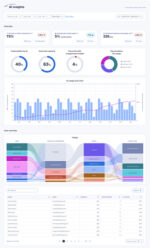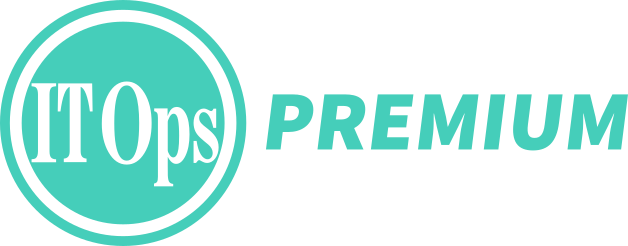
Precisely mapping the evolution of AI is practically an impossibility, considering that AI capabilities evolve extremely quickly. Whereas it may take years for people to acquire certain capabilities, current AI systems learn them in hours, days, or weeks of training. Every year of AI progress can feel like years’ worth of change from a human perspective. Amazon e-commerce consultants Ecom Ondot theorize that one year in AI could equal 10-20 human years.
One thing for sure is that the AI market continues to evolve and grow at pace, with no signs of slowing down. According to research published by Bain & Company, the total addressable market for AI-related hardware and software could approach $1 trillion by 2027, growing by 40% to 55% annually.
In tandem with that growth, modern enterprises generate a staggering volume of data. 2023 figures from Statista chart the growth of the data generated globally year-over-year since 2010. It is estimated that 90% of the world’s data was generated in the last two years alone. In the period 2010-2023, the amount of data generated has increased by an estimated 74x from just 2 zettabytes in 2010.
From Alert Fatigue to Contextual Intelligence
One of the byproducts of the sheer volume of data produced in IT operations (ITOps) is an increasing number of alerts. Organizations running hybrid cloud environments, microservices architectures, and distributed systems can receive thousands of notifications daily. Excessive alert volume, allied to factors such as a lack of prioritization, false positives, vague ownership, inconsistent alerting systems and non-actionable alerts, have created what industry professionals call “alert fatigue” – a condition where teams become desensitized to warnings, increasing the risk that critical issues get lost in the noise.
Clearly, this is neither a smart nor sustainable business practice.
It also highlights a critical challenge: modern IT infrastructure has become too complex for traditional monitoring approaches to handle effectively.
To address this and reduce the demands on IT teams scrambling to respond to system alerts at inhuman hours of the day, AI Operations (AIOps) have evolved, going through a process of maturation from reactive monitoring to intelligent operational orchestration. This evolution represents a shift from AI as a detection tool to AI as an active participant in problem resolution and prevention.
The maturity of AIOps is symptomatic of larger organizational transitions toward digital transformation. With organizations increasingly depending on complex, distributed systems, the conventional human-driven incident response model is economically unsustainable as well as operationally suboptimal. The new modus operandi leverages AI as an amplifier that takes cues from human input and performs it on a scale, rather than as a human replacement.
Legacy monitoring tools are rooted in simple threshold-based rules without business context, conveying zero information as to whether an alert is a regular spike in usage, an evolving problem, or a severe condition that must be addressed on the fly. Advanced AIOps solutions transform raw alerts into actionable intelligence through smart alert aggregation that bunches many signals together to provide rich incident overviews.
Machine learning (ML) algorithms grade the severity of alerts based on a variety of parameters like business impact, past resolution time, and the state of the current system to enable teams to distribute their response efforts effectively rather than responding to issues in the order they were received. AI looks at past events to provide insight into whether current situations are normal variations or true anomalies, reducing false positives by seeing seasonal trends, usage patterns, and normal operating bounds for each system element.
Now, instead of receiving separate alerts for high memory usage, slow response times, and increased error rates, teams receive a single notification explaining that the web application is experiencing performance degradation due to a memory leak in the checkout service. Advanced platforms connect technical metrics to business outcomes, so an alert does not just report that a database is experiencing high load but explains that this condition is affecting the customer order processing system and could impact revenue if not addressed within, for example, the next 30 minutes.
Predictive Prevention and Human-AI Partnership
The “old” reactive ITOps problem-solving approach to work set up a vicious cycle where IT teams were devoting most of their time to firefighting rather than improving system reliability. In this new world, AIOps labors tirelessly, employing historical data and ML to identify the signs of impending system failure through advanced anomaly detection that establishes baseline behavior patterns for system elements and pushes it to identify deviations that propagate failures.
By analyzing correlations among different system measurements, AI can identify precursors to problems. For example, a gradual increase in database query response times with rising memory consumption may indicate an imminent app crash despite individual measurements being within tolerable values. AI detects cyclical patterns of activity in the system, distinguishing between normal seasonable peaks and reason for alarm, preventing teams from reacting to projected increases in loading as if they were abnormal but alerting genuinely out-of-pattern behavior to examination.
The most sophisticated development in AIOps maturation involves fundamentally rethinking how humans and AI systems work together. Advanced AIOps platforms implement a continuous learning cycle that amplifies human expertise through AI-first resolution attempts for routine issues while escalating complex problems that require human insight. When AI encounters situations beyond its current capabilities, it engages human experts through natural language interfaces, explaining what it has tried, what results it observed, and what specific guidance it needs.
During human-AI collaboration, the system captures not just the solution but the reasoning process behind it, including understanding why certain approaches work in specific contexts and how to adapt solutions for similar but not identical scenarios. As AI learns from human experts, its ability to handle complex scenarios improves progressively, with systems typically evolving from 30-40% autonomous resolution to 70-80% effectiveness through proactive remediation and continuous learning. Research consistently shows that while initial AI implementations achieve modest improvements (20-40% range), mature human-AI collaboration systems with proactive remediation capabilities reach much higher effectiveness levels (70-90% range) through continuous learning and process optimization.
The Coordination of Agents
Modern AIOps platforms move beyond monolithic AI systems to implement specialized agents that work in concert. This architecture provides several advantages over traditional approaches:
- Specialized Expertise: Each agent type focuses on specific capabilities, enabling deeper optimization and more sophisticated functionality within its domain.
- Modular Deployment: Organizations can implement specific agent types based on their needs without requiring full platform deployment.
- Scalable Architecture: Additional agents can be added as requirements evolve without redesigning the entire system.
The coordination between agents represents sophisticated operational intelligence through dynamic task assignment, workflow optimization, and resource management. Complex incidents often require multiple agents working in sequence or parallel, with the orchestration system optimizing these workflows for efficiency and effectiveness while managing escalation to human experts when agent capabilities are exceeded.
The exponential development of unstructured data within the IT infrastructure presents a huge challenge to traditional ML techniques that rely on labeled data sets. Millions of log entries, incident tickets, and operational documentation with valuable insights but without the structured labels for supervised learning techniques are created by organizations. Advanced clustering techniques identify natural groupings within operational data without requiring pre-labeled examples, while large language models analyze unstructured text to generate labels and categories automatically. This approach can process incident tickets written in natural language and assign appropriate classifications, severity levels, and routing information without human intervention, dramatically reducing the time investment required while maintaining accuracy and consistency.
Business Impact and Competitive Advantage
Today’s IT infrastructure is much more advanced than can be achieved by traditional operations practices. Businesses must now contend with hybrid cloud environments spanning multiple providers, microservices-based architectures with hundreds of interdependent pieces, and distributed systems that execute across global networks. The sophistication of skill required to understand and troubleshoot such systems surpasses what most firms can provide across all technology spaces because business users expect near instant problem resolution whose underlying causes may be complex and cut across multiple layers of the system.
Mature AIOps platforms handle routine issues automatically, freeing human experts to focus on strategic improvements and complex problems that require creative problem-solving.
AIOps platforms correlate logs, metrics, and traces to cut alert noise by up to 75%, while organizations typically see a 15-45% reduction in high-priority incidents and 70-90% reduction in incident investigation time with mature AIOps implementations. Mature AIOps analyzes data to predict equipment failures and maintenance needs, reducing unplanned downtime by 20-40% and extending asset life, according to Forrester.
When issues do require human intervention, AI provides comprehensive context, suggested solutions, and automated execution capabilities that dramatically reduce resolution times, with mean time to recovery improvements of 50% being common within six months through faster root cause analysis.
Customer satisfaction and loyalty are directly impacted by system downtime or performance problems, while reliable IT systems enable higher productivity for all business operations.
Sufficiently mature operation organizations can implement newer features and services quicker because they believe that their systems will be stable despite the changes.
Organizations with well-demonstrated, scalable IT infrastructure are better able to respond more quickly to market opportunity and competitive threats and bring new products to market, expand into new markets, and address changing customer requirements more quickly than less mature firms. Strong ITOps reduce overall business cost, enabling competitive pricing or enhanced profit margins, and high-maturity AIOps capabilities signal to potential employees that the organization invests in sophisticated tools and practices, which makes them more attractive to top technical talent.
The Future of Operational Excellence
The evolution from monitoring to orchestration is AIOps “growing up” in measurable ways that distinguish mature systems from mere monitoring tools. The transition from reactive firefighting to proactive problem-solving fundamentally transforms operational dynamics, and mature systems provide actionable intelligence in business context rather than raw metrics requiring interpretation. Mature platforms refine their function continuously through interaction with human knowledge and outcomes analysis, accumulating new insight over time rather than executing pre-programmed routines.
The evolution of natural language incident management interfaces demonstrates how AI has come a long way toward actual collaboration, where teams are able to reason about problems using AI systems, ask questions, and receive context-specific explanations rather than simple alert notifications. Next-generation platforms integrate predictive capability natively into operational processes so prevention is as natural and autonomous as detection without requiring additional human effort or process modifications.
Maturity of AIOps is the actual form of a persistent shift for organizations to deal with ITOps, where the future is not about replacing human intelligence but augmenting it through intelligent orchestration that learns, predicts, and acts with increasing maturity. Mature AIOps solutions make operational excellence the default state instead of an aspirational goal, where systems are optimized automatically to deliver maximum performance, pre-empt and steer clear of troubles, and continually improve their capabilities. While AI handles routine day-to-day operations, human experts can be focused on strategic programs, architectural innovations, and innovation projects that generate business value, while the ability to capture and leverage human expertise at scale creates exponentially high returns on investment in expert knowledge.







